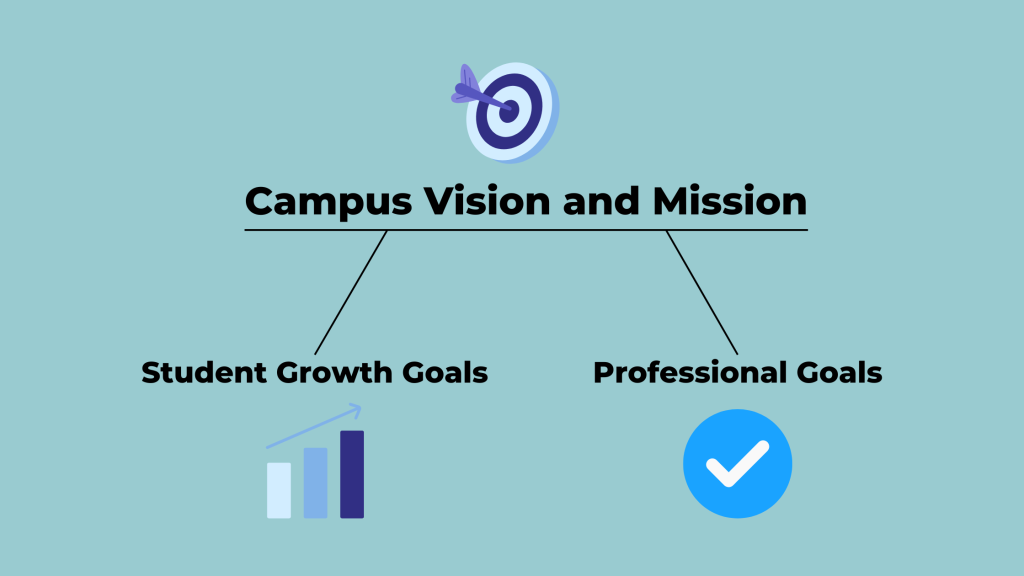The school leaders are responsible for guiding students, staff, and the entire campus toward growth and success. This requires unwavering focus and planning. A common pitfall in the work of an administrator is losing sight of that focus and becoming reactive to everything that comes up. Daily, many competing urgencies call the campus leadership’s attention, and if you’re not intentional about your focus, you will find that you are constantly chasing the work. When that happens, it’s time to stop and reprioritize the focus for the campus.
Some questions to consider: What is our shared purpose? Are we prioritizing time to ensure this is getting done? A typical school saying is, “That which is measured improves.” As leaders, we must identify the purpose, measure the campus’s progress toward success, and ensure that this work includes all departments and teams on the campus.
One of the most effective strategies for ensuring that everyone is working toward a common purpose and keeping the prioritized work front of mind is implementing cascading goals that align with the campus’ overarching objectives. This approach fosters coherence and unity and empowers individuals at every level to contribute meaningfully to the school’s success.
Why Cascading Goals Matter

Alignment with the School’s Vision and Mission
Cascading goals ensure that every action taken within the school is directly linked to its overall vision and mission. By aligning individual and departmental goals with broader campus objectives, everyone understands how their work contributes to the school’s success.
Improved Clarity and Accountability
When goals are clearly communicated and connected across all levels, there is less confusion about priorities. This clarity not only helps staff focus their efforts on what truly matters but also fosters a sense of unity, minimizing the risk of working at cross-purposes.
Download our free Cascading Goals Planning Document to start the goal-setting process!
Cascading goals establish clear expectations for each role within the school. This transparency holds individuals accountable for their contributions and fosters a culture of responsibility and ownership.
Enhanced Collaboration and Engagement
With aligned goals, collaboration between departments and teams becomes more seamless. Everyone is working toward common objectives, which naturally encourages cooperation and sharing of resources and ideas.
Cascading goals play a crucial role in our success. When individuals see how their work directly impacts the school’s success, they are more likely to feel motivated and engaged. Cascading goals provide a sense of purpose and belonging, driving higher levels of commitment and effort.
How to Get Started with Cascading Goals
1. Start with Data to Determine the Campus Goals

Begin by clearly defining the campus-wide goals. Based on your campus’ current data, where are the 1-2 highest priority areas for refinement? Using this information, develop 1-3 straightforward, targeted goals for the campus. These should be specific, measurable, achievable, relevant, time-bound, inclusive and equitable (SMARTIE). You may think about goals supporting student achievement growth, staff development, community engagement, or operational efficiency.
2. Listen to Key Stakeholders
Engage key stakeholders in goal-setting, including teachers, administrative staff, students, and community members. It’s often said that “those closest to the problem are closest to the solution.” Provide opportunities to amplify and listen to the voices of those directly impacted by the work that needs to be done. Their input ensures that the goals are realistic and reflect the needs and aspirations of the entire school community.
3. Break Down the Cascading Goals and Communicate Them Clearly
Once establishing the campus goals, break them down into specific objectives for different departments, teams, or individuals. Each department or team’s ability to contribute to the work determines the organization’s lasting success in achieving its goals.

Break the goals into smaller, relevant objectives and connect them to each team’s work. All staff on your campus will set goals as part of their annual evaluation; their student growth goals or professional goals should connect to the larger goal of the campus. Connecting these to the broader campus goals creates a clear line of sight from individual contributions to overall success.
Ensure everyone understands their role in achieving the campus goals and how their objectives align with the larger vision. Have them begin to plan out their plan of action. What actions, training, and support do they plan to take to start working toward this goal? Regularly communicate the progress of the team-specific objectives and the campus goal; celebrate successes along the way.
4. Monitor, Adjust, and Support Your Staff
Monitor progress regularly and be open to adjusting as needed. Schedule time to check in on these cascading goals: Add it as a monthly or quarterly agenda item with your team leads or faculty meetings. We must intentionally focus on the campus goal and include all team members in the conversation. Are we making progress toward this goal? Which barriers need adjustment? How can we address the issues and continue making progress? What successes have we experienced along the way?
This focus and growth mindset for the goals allows the flexibility to respond to changing circumstances while keeping everyone aligned with the campus objectives. To achieve their goals, staff need access to the right resources, training, and support. Ensure that these are readily available and that any barriers to success are addressed promptly.
5. Celebrate Achievements & Plan Next Steps

Recognize and celebrate when you and your team meet your goals. This not only boosts morale but also reinforces the importance of aligned efforts. Publicly acknowledging achievements helps build a culture of success and continuous improvement. As you celebrate your successes, consider some possible next steps to continue to improve. Where will you head next on the campus’ journey for continuous improvement?
Tips to Remember for Cascading Goals
- Maintain Focus on Student Outcomes: Student success is at the forefront of every conversation and decision related to goal-setting.
- Use Data to Inform Goals: Data-driven decision-making ensures that goals are based on evidence and are more likely to lead to meaningful improvements.
- Ensure Consistency: Regularly review and refine goals to ensure consistency across all levels.
- Empower Leadership at All Levels: Sustainable change comes from shared leadership. Encourage leaders at every level—department heads, team leads, and even student leaders—to take ownership of the cascading goals process.
- Foster a Growth Mindset: Promote a culture that values continuous improvement. Encourage staff and students to view challenges as opportunities to grow and contribute to the school’s goals.
Creating cascading goals that align with campus objectives is a powerful way to ensure everyone in your school is moving in the same direction. This strategic approach fosters clarity, accountability, and collaboration, all essential for achieving the shared vision of success. Following the steps and tips outlined above, you can create a goal-setting process that drives meaningful progress and elevates the entire school community.
Natalie is an Educator Evaluation and Leadership Administrative Specialist at ESC Region 13.






Add comment